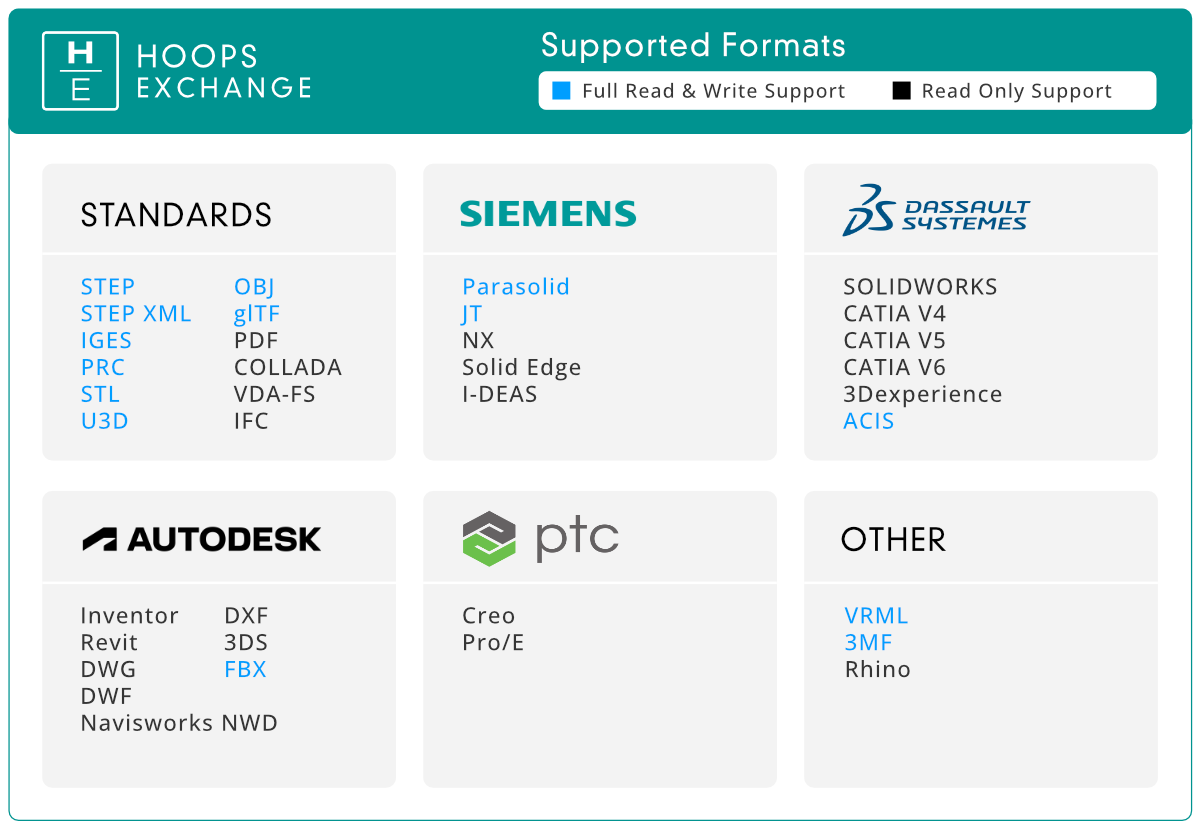


CAD Data Access Library
The HOOPS Exchange SDK is a set of software libraries that provide developers with the ability to read and write popular 2D and 3D formats from within their application. HOOPS Exchange reads CAD data from the most popular 3D file formats and converts that 3D data to the PRC data format, a highly compressible and open file format that is ISO certified. PRC is also one of the container formats used for 3D in Adobe PDF.
HOOPS Exchange is optimized to read various kinds of 3D data, especially those coming from CAD systems. Most of the data types stored by CAD systems are supported by HOOPS Exchange:
Assemblies and parts
Trees of 3D entities (coordinate systems, wireframes, surfaces, and solids)
Exact geometry representation for curves and surfaces
Topological structures for surface and solid models
Tessellated (triangulated) representation
Markup data including Product and Manufacturing Information (PMI)
Metadata such as name, color, layer and other non-geometric data

Typical CAD Conversion Uses
Users of HOOPS Exchange are developing applications for a variety of different markets, from traditional mechanical design, engineering and manufacturing to markets in which mechanical data is used but is not seen as core to the activity of that market – for example, construction, plant design, shipbuilding, and energy. For most industries, the following use cases are common: Visualization, Modeling, Archiving, and PDF Publishing.
For most industries, the following use cases are common:

Access 30+ CAD Formats
The HOOPS Exchange data translation SDK allows you to read and write a wide variety of file formats without needing to license any additional technology. You work through a standard interface, so once you complete an integration, you have access to the large number of formats supported by HOOPS Exchange and can easily access newly supported formats as well as updates to existing versions.

The writers are often used by developers to speed the development of integrating HOOPS Exchange technology into their application. For example, if you are a Parasolid or ACIS based application you can use our XT or SAT export to export the B-rep definition of the model.
Click here to view the specific capabilities of each reader and writer in addition to detailing any other relevant features and limitations.

Reading 3D Files
Reading CAD files into a HOOPS Exchange-enabled application is a very simple process. Simply set the options to control what data is read, and then call a single API to load the CAD file, which provides access to the original CAD data in the PRC data format. Learn more about reading files into HOOPS Exchange in our technical documentation, including using HOOPS Exchange with Parasolid and other modelers.

Accuracy
HOOPS Exchange has a full topological structure for describing manifold and non-manifold models. Local tolerances can also be retained for vertices and edges.
The PRC file format comprises the union of all geometric entities defined and used by the major mechanical CAD systems and relevant open standards e.g. STEP and IGES. Each entity is stored in the original parametric form as defined by the originating modeling system. Therefore, PRC has a significant advantage over many existing standards as there is no requirement for loss of precision or accuracy when 3D curve and surface data is represented in PRC.

Compression
Files stored in the PRC format can be highly compressed. A compressed PRC file written by HOOPS Exchange can be typically 100 times smaller than the original proprietary CAD file and is typically three times smaller than U3D, a legacy 3D format still used in PDF.

PMI & Markup
Product and Manufacturing Information (PMI) is read by HOOPS Exchange and stored in the Markup classes. As well as providing a complete graphical representation for semantic PMI, HOOPS Exchange maintains the logical hierarchy of the PMI as represented in the CAD system.
PMI markups are associated with assemblies, sub-assemblies and parts. If relevant, PMI is associated with individual topology so that feature control frames and datum references can be displayed correctly. Leader lines attach markup items to geometry. HOOPS Exchange works to provide an accurate tessellation that looks exactly as it does in the originating CAD system.

